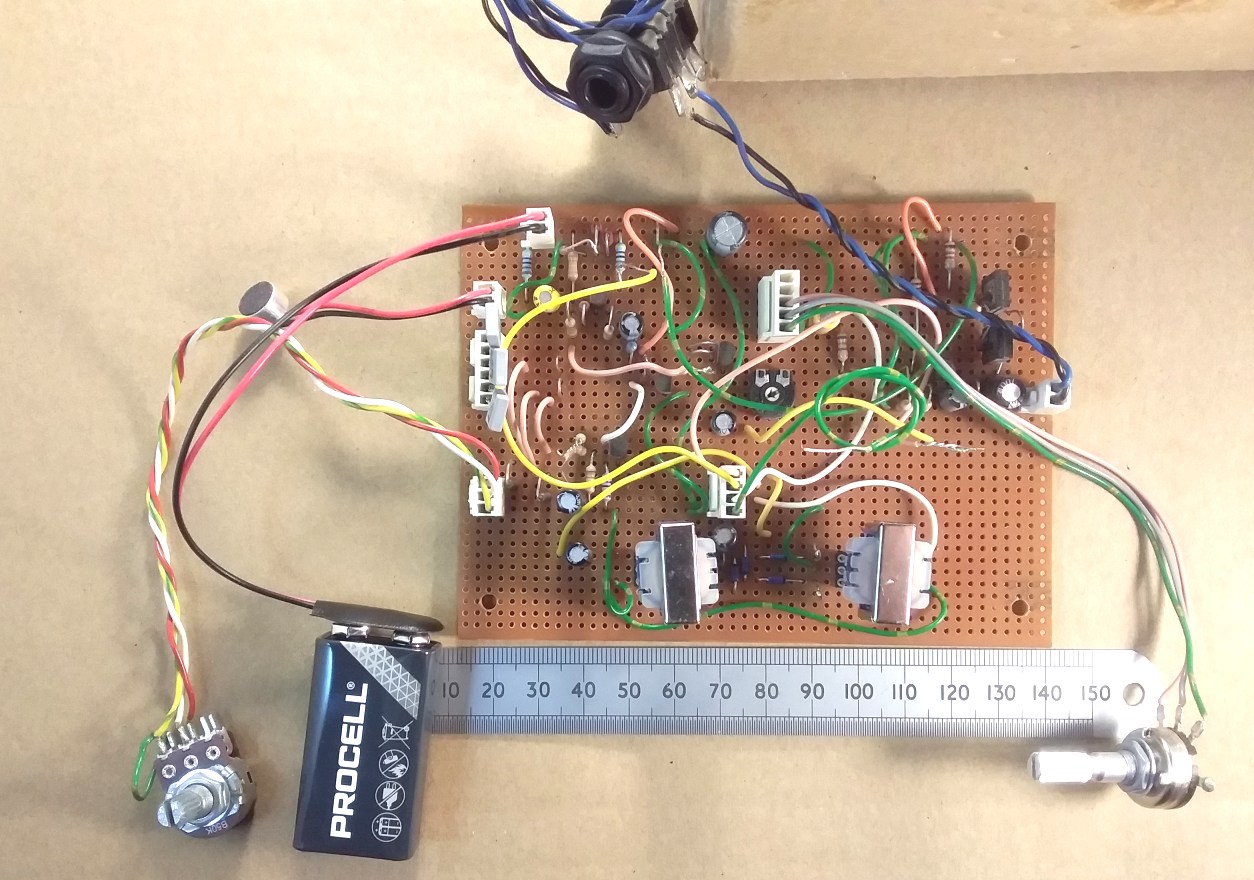Portable Dalek Voice Modification Ring
Modulator Circuit
Advertisement:
If you're enjoying these pages and you have an interest in
hobby type electronics or repair jobs, you might like to
visit my UsefulComponents
Etsy Shop
where there are many difficult to find items, and my other
website www.usefulcomponents.com,
where there are details of some good radio and other kits.
Introduction:
Back in 2011 I started selling electronics parts online and
put together a simple ring modulator kit like this:
The
Useful Components Ring Modulator Kit
So far so good. Every so often though, customers want
a whole portable unit to do a Dalek voice, and they want do
make it themselves rather than buy one of the plastic
Chinese things. So, back in 2011 I knocked together a
breadboard for a bit of amusement, and just to make sure
that my claim of being able to make a Dalekky sounding voice
with that basic ring modulator core would be possible.
We're on Interesting Electronics here rather than Useful
Components, so this design is provided as a circuit that has
been made and tested. It is not available as a kit or
board, and I don't claim that this is the best way to do
it. It is definitely one way to do it though,
and I think that it sounds quite good.
Schematic Circuit Diagram Of The Portable Dalek Voice
Modification Unit:

As ever this is displayed here at the width of a postage
stamp to stop Google Search Console complaining that it is
"not mobile friendly," but users of proper computers can
click on the image to enlarge it, or download the pdf at the
following link:
PDF
Schematic Circuit Diagram Of Portable Dalek Voice Changer
Unit
Schematic Walkthrough of the Portable Dalek Voice
Modification Ring Modulator Circuit
Starting at the microphone input bottom left. R9
provides the standard bias for a commonplace condenser
microphone element. Q4 is a very standard common
emitter amplifier configuration working near maximum
available gain. C7 blocks the D.C. and the voice
signal feeds ring modulator transformer L1. Top left,
a classic phase-shift oscillator, but with an output buffer
to ensure sufficient feedback and some slightly nifty
limiting shenanigans involving R4 and R5. We don't
need a perfect sine-wave so that's all well and good.
L1, L2, and D1 though D4 are the classic ring modulator core
using diodes and centre tapped transformers
configuration. Bottom right, VR1 onwards is the volume
control and simple class B amplifier for driving the
loudspeaker.
Pictures Of The Portable Dalek Voice Ring Modulator
Prototype




What we're all waiting to know. What does it actually
sound like? Hopefully you can view and hear my top
quality video at the link below:
Portable Dalek Voice
Unit Video Test
If that doesn't work, Also available on YouTube: Portable
Dalek Voice Unit Video Test
More Things To Do
Someone has suggested that another thing that you might want
is a relay output that closes a switch when voice is
present. This could activate the two Austin Mini
indicator lights on the head via a battery. As a
1960's BBC Dalek operator, that would have saved you from
having to pull the light switch cord in time to the actor's
voice off-stage, while simultaneously waggling both the eye
stalk, squirty gun, and of course, the classic sink
plunger. Easily done. In true Blue Peter style,
I am told that Davros is working on such an
improvement. But he also says that he's a bit busy at
the moment making a simpler version of this design to supply
as a kit which will hopefully include some lights that will
flash along with the voice output.
Apocryphal Tales
In times long past, the BBC had a habit of losing the ring
modulators. They only had two for a while, and
no-doubt the Radiophonic Workshop were keen to keep their
claws on theirs, and not to have that one nicked as
well. At one audition, the prospective Dalek voice
actor said, "Oh, so what; You want me to do it without the
effects unit, Luv? No Problem!" And he
did. Perfectly:)
Other Notes
If you were viewing the schematic published on this page a
while back, there was a mistake in it around R3, and the
Q2 biassing. I'd changed this on the original
schematic while building the breadboard, but failed to
update the change to this site. Naughty!
Thank-you to the observant viewer who pointed this out via
email.

Edit History
03-OCT-2024:
Schematic correction around R3 and Q2 biassing. (Removed rogue
"wire")
Navigate
Up




